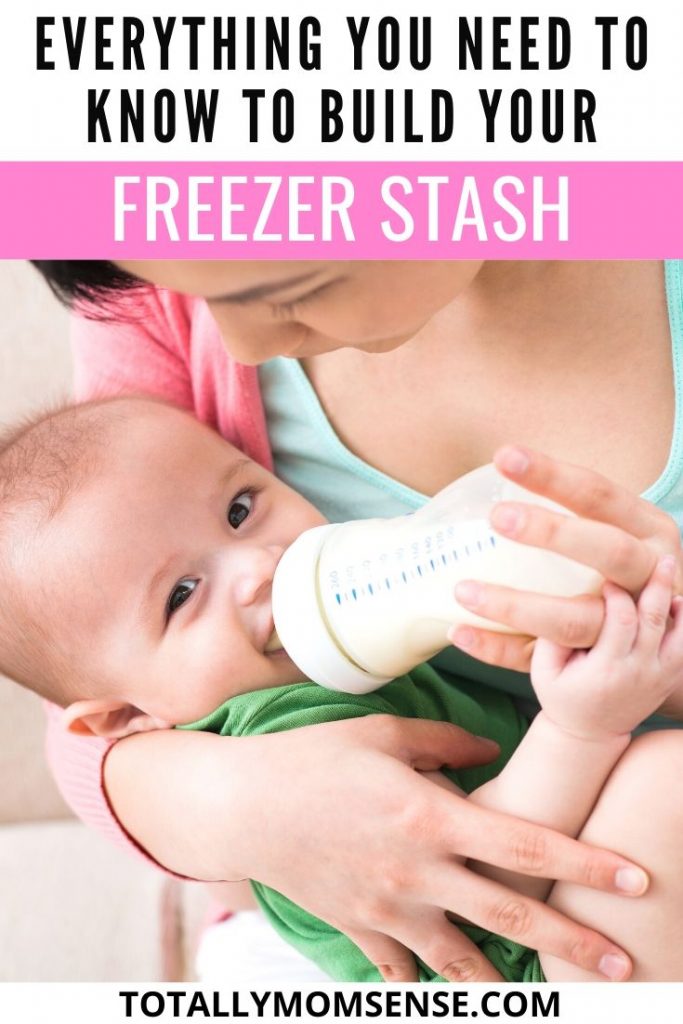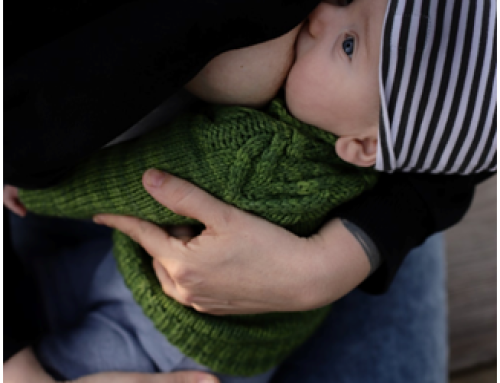Packed with valuable tips and tricks on how to effectively rotate your freezer stash so that it can last your baby longer!
Are you a breastfeeding mom and worried about stocking enough milk for your baby once you are back to work? I was in the same boat! Fortunately, I was able to spend four golden months with my brand-new baby before getting back to work. The idea of feeding, pumping and stocking my freezer with enough supply of milk to last my daughter used to often make me feel anxious. As a new mom to my baby girl, everything felt so new and sometimes not that easy at the beginning. I was tired, sleep-deprived, learning about how to take care of a baby for the very first time and the thought of going back to work used to worry me often.
The more I read about stocking and pumping breastmilk, the more confused I began to feel. I was supposed to get back to work in a few months and my biggest concern of all was that I had no idea about how much milk I would need. Now looking back at all those moments, I realize how ignorant I was. I kept reading all these blogs on Pinterest on how moms saved over 100 ounces of milk in their freezer and I often began to question myself if that is even possible.? Honestly, it is, and there is no big rocket science to it. My breastfeeding journey lasted me for a year and I partly fed my daughter pumped milk from four months onwards.
Before moving forward into this post, I would like to introduce you all to the Ultimate back to work pumping class by Milkology. This course is packed with valuable insights on day to day pumping at work and tips on successfully transitioning back to work. I had taken the other Ultimate breastfeeding class again by Milkology at the start of my breastfeeding journey and had found it extremely useful. You can take these courses from the comfort of your home as it’s online and it is packed with the necessary and all the required information that you would require to get started on your breastfeeding journey. And the best part is that these courses are only for $19.
Pin this post to keep it handy all the time!

When should I start pumping for my freezer stash?
It usually takes a couple of weeks for the milk to come in for a new mom. Milk supply for a nursing mom all depends upon feed and demand. The more you feed your baby, the more milk your body will be able to produce. In order to do so, it is most recommended to breastfeed your baby on demand for those initial few weeks and hence it is great to wait out for at least 4-6 weeks before you start pumping as by then you will be able to have a feeding schedule for your little one in place. But nevertheless, if you still need to pump before that you can do that too. I have known moms who had to pump from day 1 due to medical reasons and they did great.
Related: Tips on handling and storing breastmilk
What is the freezer stash used for?
Freezer stash can be used for two reasons.
- To be able to feed your baby.
- In case of emergencies when your milk supply is less, or you are unavailable to feed your baby
It’s a good idea to freeze a few ounces of breastmilk even if you are available to feed your baby all the time so that in future there is never any need to cry over spilled milk.
Related: 20 breastfeeding hacks for new moms
How do you make a freezer stash?
There are a few ways that you can use to slowly start building your freezer stash one day at a time. A few pointers to keep in mind while working towards building your freezer stash are.
- Start several weeks before in advance. If you are returning to work, it is best to start building your freezer stash from a few weeks in advance, as it can take some time for you to form a pumping routine at work
- Pump early in the morning! I used to breastfeed my daughter first thing in the morning using one breast and then pump milk from the other breast for my freezer stash
- Also, pump one more time in the evening mostly before your bedtime.
Some moms like to pump after each nursing session that can get too exhausting. Hence, it is best to start building your freezer stash from early on, so that you don’t have to pump many times later on to build your freezer stash.
You can use this free Sample Feeding Schedules.pdf of three sample feeding schedule to help you get started on forming a feeding routine with your baby.
How much of a freezer stash do I need?
Typically, before you get back to work you should aim to have at least a week of your baby’s feeding stocked up in your fridge. Getting back to work after maternity leave can feel like a big challenge emotionally as well as physically and there will be a lot that will need to be planned and getting used to. Hence, baby feeding should be your last concern on your mind. Hence aim to stock at least 1-2 weeks of daytime feeding for your baby.
For example: When I had to return back to work my daughter was four months old. She was taking anywhere between 7-8 feedings in 24 hours. I would breastfeed her first thing in the morning and then pump a bottle that I would stick in the freezer. For her daycare, I would have already prepared 3-4 bottles from the previously stocked breastmilk in the freezer. After I would get back home in the evening, I would breastfeed my daughter and then before my bedtime pump another bottle and stock it in the freezer. While at work, I would follow the exact same schedule that I would have followed at home to breastfeed my daughter and pump at all those times. This way I was able to breastfeed my daughter for up to a year.
Related: Tips for the successful transition on returning back to work after maternity leave
How long does frozen breast milk last in the freezer?
Once you figure out as to when you would want to start pumping, the next step is to start planning on how you would be handling and storing the breastmilk. There are three forms in which you can handle breastmilk – freshly expressed milk, refrigerated milk, and frozen milk. Just, in brief, the storing guidelines are:
- Freshly expressed milk – This form of milk is when you have pumped fresh breastmilk to feed your baby. Freshly expressed milk can be used for feeding right away or it can be kept at room temperature I .e.., 61-71F for up to 4 to 8 hours. Although at cooler room temperatures you can keep the milk outside for up to 8 hours, usually 4 hours is preferred
- Refrigerated milk – You can refrigerate a freshly expressed milk in a standard refrigerator at your home for up to 3 – 8 days. Although 3 days or less is the preferred number. And if you are refrigerating the milk in an insulated cooler with ice packs, you can keep the milk for up to 24 hours
- Frozen milk – Freshly expressed milk should always be immediately transferred in milk storage bags or bottles and then placed in the freezer. A packet of frozen breastmilk can last anywhere between 6-12 months (although 6 months is preferred)
You can take a printout of this pdf – guidelines to store and handle breastmilk and stick it on your fridge to remind you!
How can I rotate my frozen stock to prevent the expiring of milk?
Make sure to organize frozen milk packets in such a manner that the milk packets expiring soon are in front of you so that they don’t get wasted. You can also buy these milkies – which has an easy one packet in and one packet out method and great for storing milk packets in the freezer. Also, while storing frozen milk lay it flat so that it will take lesser space. I have an entire blog post on how to handle and store breastmilk with a few more tips, make sure to check it out when you start using a breast pump. Click here to read how to handle and store breastmilk.
In my case, I would use the frozen milk for her daytime feeding in school as it was very difficult for me to prepare fresh milk bottles in the morning due to time constraints and I was only able to feed her fresh milk when I would get back home in the evening. You could also create one fixed day a week when you will only be feeding your baby frozen milk or fixed timings in a (like in my case), where daytime was frozen milk and early morning and evening was fresh milk feed.
Some moms are known to suffer from excessive lipase condition where their breastmilk turns sour or soapy after some time. Hence it is most important in those cases to effectively use the already frozen breastmilk before it changes the taste.
Related: Tips for nursing moms with excessive lipase condition
How many ounces should I pump per session?
It is typical for a mother who is breastfeeding full-time to be able to pump around 1/2 to 2 ounces total (for both breasts) per pumping session. And for an exclusively pumping mom, it will be somewhere between 5-8 ounces total (for both breasts). Although please note, this is not the standard and will vary from mom to mom and will largely depend on their diet.
How do I choose the perfect pump?
Choosing the right breast pump is not only about comfort but also about efficiency. When you are choosing a pump, it is important that the flange (also known as breast shield) fits you properly. If it doesn’t then that can cause soreness, redness and even reduce the amount of milk that you produce.
Standard Breast Pump Flange – The breast pump flange is the part that connects your breast to the pump. When you pump milk will travel down the tube to the bottle. After you give birth and while you're pumping, it is very common for your breast to change the size, so you may need multiple flanges for your pump. It's a good idea to check the fit from time to time. All breast pumps come with at least one average-sized breast pump flange. The average flange is between 24 and 27 millimeters (mm), which corresponds to the size of your nipple. But not all women fit into these sizes. There are a range of smaller and larger flanges available with size ranges from 21mm to 36mm.
Did you know that you can get a breast pump for free from your insurance? All you have to do is simply fill out this form at Aeroflow, and they will contact you. Aeroflow has a variety of breast pumps to choose from and they will help you with all the details on how to avail your breast pump for free from your insurance.
Get your free breast pump here!
How can you know that the pump fits you?
There are a few ways to tell whether the pump fits you properly. Here they are!
- Your nipple is centered in the flange and moves freely in the tunnel of the breast pump
- You should not be able to feel areas of the breast that still have milk inside. This indicates an uneven removal of milk
- You should not experience pain in your nipple
Not having the right size breast pump flange can result in problems. For instance, you may not be getting the most amount of breast milk possible and this may lead to blocked milk ducts. A poor fit may also cause nipple damage, so it is very important to choose the right size of the pump for you! Also, if you are a working mom soon going to get back to work, then you can read here on how to plan and organize your pumping bag for work. It’s filled with all the required stuff that you would require for your easy transition back to work after maternity leave. Click here to get the list of all the essentials to organize your pumping bag for work.
Can I mix breast milk from two different days?
Milk from different pumping sessions/days may be combined in one container, use the date of the first milk expressed. Avoid adding warm milk to a container of previously refrigerated or frozen milk. Cool the new milk before combining it. Breastmilk is not spoiled unless it smells really bad or tastes sour.
Related: Easy and effective methods to warm milk bottles in the night
How can I increase my milk supply in one day?
The milk supply for a nursing mom all depends upon the demand-supply method. The more milk your baby needs, the more milk your body will produce. As a new mom, it might often feel that your body is not producing enough milk. I get that! I have been there. In my initial few weeks of breastfeeding, I used to often feel extremely anxious as to whether I was producing enough milk for my daughter.
For a nursing mom, maintaining a good diet should be your priority. After all good diet is what produces the milk. There are few tips to keep in mind when it comes to enhancing your milk supply. Let’s discuss them!
- Keep yourself hydrated as it helps a lot in producing milk
- Nurse often and on-demand as that will help you establish your milk supply as well as help in regularly emptying your breasts
- Maintain a well-balanced diet. Well, there is no doubt about that! Nursing moms need an extra 500 calories a day. Try taking in nutritious and protein-rich food like oatmeal, eggs, veggies, fruits, almonds, fenugreek, etc.
- Nurse for at least 15-20 minutes on each breast before switching to the next one
- Keep milkmakers as snacks always handy. You can find a bunch of them on amazon
- Try taking in lactation teas. Again, they are available on Amazon and they can help you relax as well as help increase your milk supply
- Make sure never to miss your daily vitamins
- If you are pumping, then make sure to pump at every feed. Never miss a feed, as the more is the demand the more milk your body will produce
Breastfeeding is a natural process and feeling too anxious about your breastmilk is like reading too much between the lines. If your baby is healthy, being active and gaining weight, then there is no need to feel concerned.
What do I do with the milk that is going to expire soon?
If you have breastmilk that is expiring soon, then instead of dumping all the frozen milk try donating it. You can check this here.












I do not have kids but I watched my sister freeze and store Breast milk all the time 🙂
Stocking and pumping takes a lot of work. It’s important to be aware of all the best resources there are that can help make this task manageable.
Wow there’s so much work that goes into it, I had no idea! Thanks so much for sharing this with all of us!
I remember these days! I was never able to pump enough to have a freezer stash, sadly! I tried.
I know the feeling. I found myself in a similar boar many times. I was too worried about being able to pump enough that I eventually stopped breastfeeding.
This is very interesting and will be super useful to all the new mums out there! Freezing your breast milk is also a new concept to me
Thanks!
My babies would not take a bottle so I did not freeze milk. This is useful for moms who work
I had to struggle with my daughter too. She was the same way not ready to take a bottle.
I am long past breastfeeding but hopefully, I will b a grandma soon. These are such great tips, I will be sure to share them. It certainly helps new parents.
Thank you Shelah! Congratulations on becoming a grandma soon.
Thank you for this great tips, I will be sure to share them with my nephews and nieces.
Pumping milk is so hard but so worth it. I realized pretty early on that the right pump is critical. Thank you for a really good and important post!
Oh wow, what an awesome article! There are lots of helpful information in it that would surely help many new mothers. Thanks for sharing this!
I wasn’t aware that you could freeze your breast milk! That’s so handy for working mums who might not be able to take their kiddos with them to work. They can just defrost their breastmilk for the babysitter/partner!
Great guide.
I’ll be sure to forward it to soon to be moms in case I come across any. 🙂
I don’t have children but I can see that this is such a helpful article for new moms. I didn’t know that you could actually freeze breast milk.
I’m not a mom yet! However, my friend has just given birth to her first baby, so I believe this article will be very useful for her. I’ll share it for sure! 🙂
Pumping and storing milk is a lot of work. I’m doing it with my third baby right now and it’s definitely time consuming (since I have to find the right time between his nursing sessions to pump) but so worth it!
Thank you for the reminder to start using the frozen stash! I need to get on top of that so not to waste it 🙏🏻